And the mechanism for their seasonal color change.
Occasionally I rerun a favorite older blog post. This one was published in December of 2014. For this version I’ve changed the title, edited the text, cleaned up the formatting (double spaces between sentences just don’t cut it anymore) and added one photo.
I decided to post this version today, in part because it’s been a while since I’ve posted and I wanted to let readers know I’m still kicking.
Farmington Bay WMA is wedged into a notch of the western slope of the Wasatch Mountains. The notch has an exasperating habit of funneling clouds incoming from the west directly over Farmington where they’re trapped. Much the same thing happens to morning fog, especially during winter, so it’s common for Farmington to be enveloped in either clouds or fog when it’s clear everywhere else. Collectively I call the phenomenon the “Farmington Curse”. That curse, this time in the form of fog, was much in evidence on the morning I spent some time with this Long-tailed Weasel.
In an attempt to mitigate some of the effects of the fog I had to do some fairly heavy-handed processing to some of the images below and it may show.
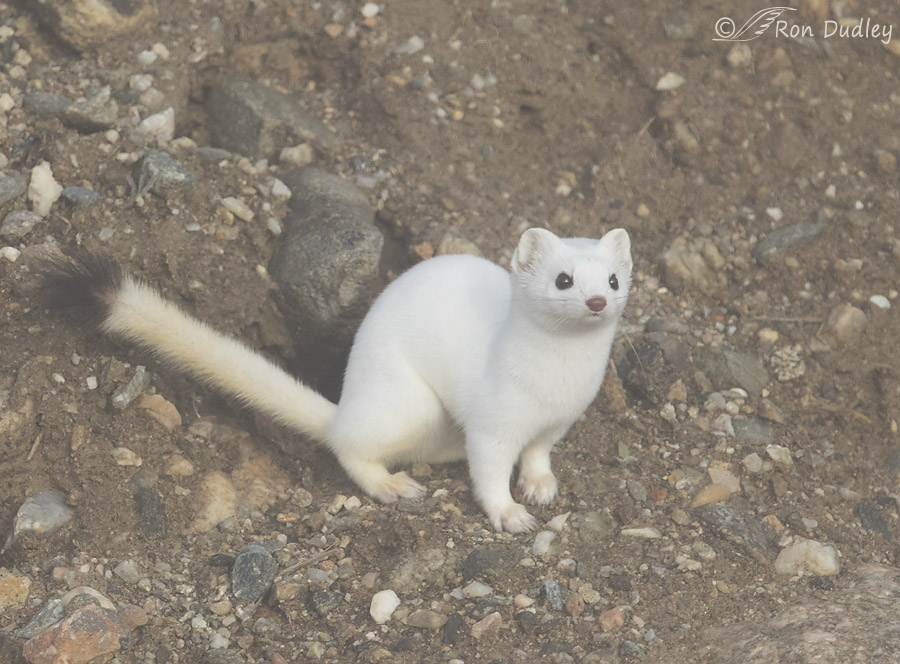
1/800, f/8, ISO 800, Canon 7D Mark 2, Canon EF500mm f/4L IS II USM +1.4 tc, not baited, set up or called in
That time of year of course ‘he’ was in his white winter coat – in winter they’re pure white except for pitch-black eyes, a black-tipped tail and a pinkish nose. He was hunting among some boulders near the north end of Farmington WMA. Typical of the species, his movements were quick and sinewy as he loped around the rocks looking for voles and possibly mice. I’ve seen mice in the area before.
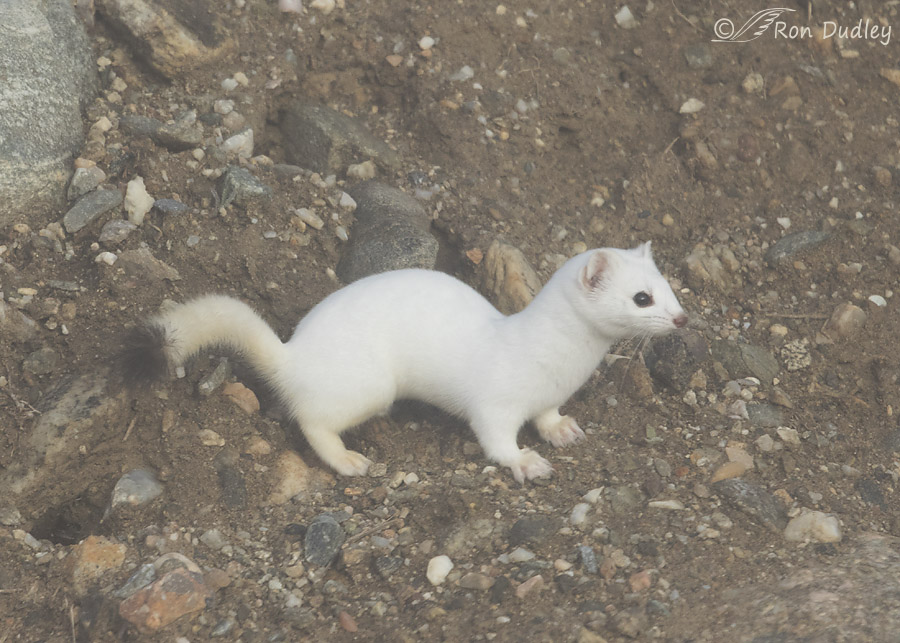
1/800, f/8, ISO 800, Canon 7D Mark 2, Canon EF500mm f/4L IS II USM +1.4 tc, not baited, set up or called in
Almost certainly the burrow entrance you see at lower left belongs to a vole. Given my tendency for dramatics, I can imagine a vole trembling in fear inside the burrow.
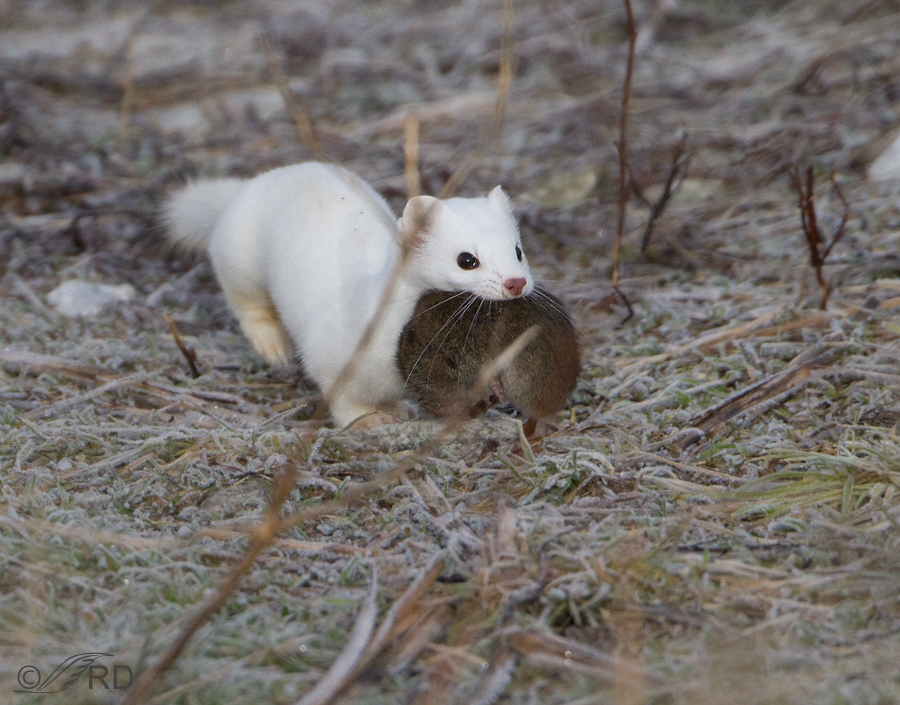
This photo, of a different weasel taken at Farmington on a different date, is one of the few photos I have of a weasel with a vole.
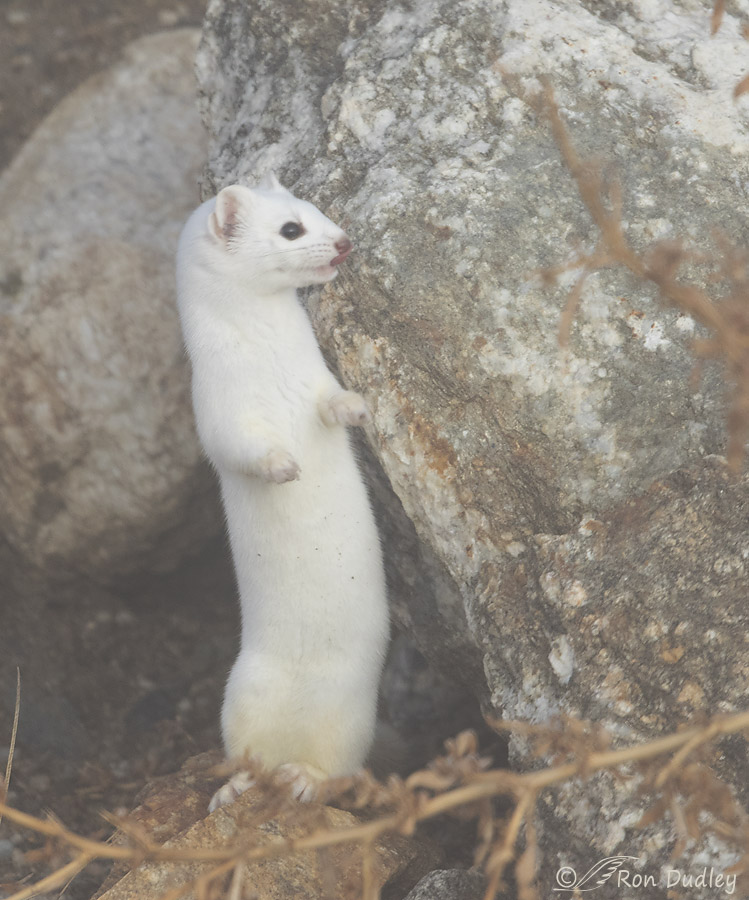
1/640, f/8, ISO 800, Canon 7D Mark 2, Canon EF500mm f/4L IS II USM +1.4 tc, not baited, set up or called in
OK, back to the first weasel. The fog often made it difficult to get a sharp focus lock on him and in this photo he’s soft. I’m including it because, even though it’s hard to see in the fog, I caught him as he was licking his nose with his tongue.
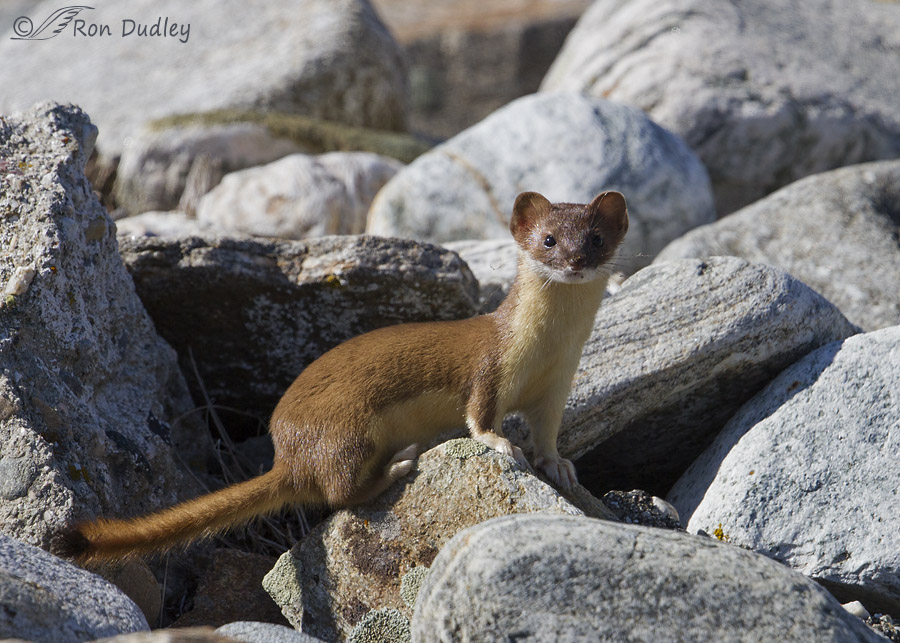
1/1600, f/7.1, ISO 500, Canon 7D Mark 2, Canon EF500mm f/4L IS USM +1.4 tc, not baited, set up or called in
To the uninitiated it may be difficult to believe that this critter is also a Long-tailed Weasel. I photographed this one earlier that summer within about 100 yards of where I found the white one in the photos above (perhaps they’re the same weasel?). In colder latitudes weasels undergo a seasonal color change for obvious reasons related to camouflage.
In southern portions of their range they don’t become white in winter. We know that the color change is genetically controlled rather than triggered by temperature change because when southern weasels are transplanted to the snowy north, they don’t turn white in winter. And when northern weasels are moved to a location in the warm south, they still turn white in winter.
For northern weasels the trigger for their genetically controlled transformation is length of day so when it’s unseasonably warm in winter, white weasels stand out like a sore thumb when there’s no snow. That makes them unusually vulnerable to predators.
And to being spotted by photographers like me.
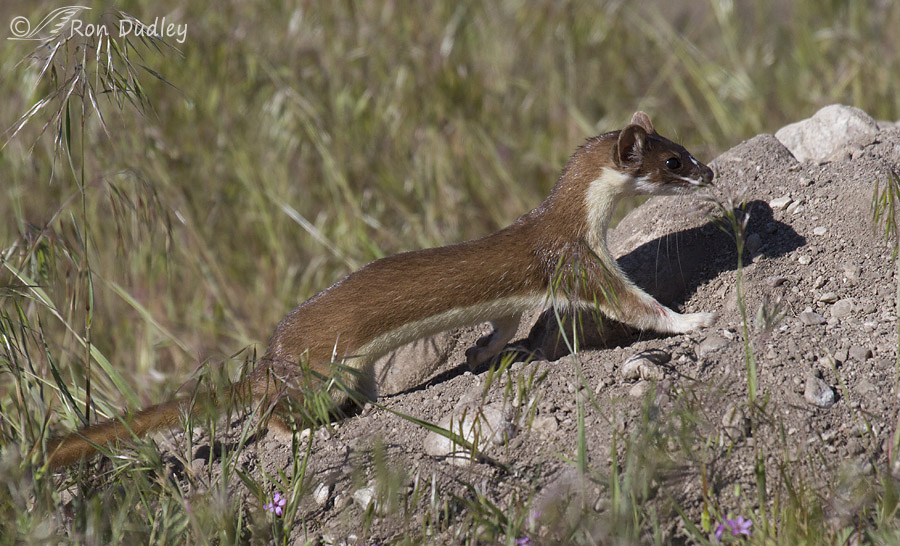
1/2500, f/8, ISO 500, Canon 7D Mark 2, Canon 100-400 @400mm, not baited, set up or called in
I photographed this weasel on a badger mound on Antelope Island in May. This view allows a good look at their long, lithe body that is designed to go after small rodents in confined spaces. It’s interesting that Long-tailed Weasels in the southwestern states often have white facial markings, as this one does, but this is the only Utah individual I can recall seeing that had some of those markings.
The only part of their pelage that doesn’t turn white in winter is their black-tipped tail. Birds of prey (especially hawks and owls) are predators of weasels and in experiments, hawks presented with a stuffed weasel that lacks the black on the tail had no difficulty identifying it as vulnerable prey and attacked the weasel’s head. However, when a stuffed weasel did have a black-tipped tail, the hawks often hesitated and sometimes attacked the tail.
That would give the fierce little weasel a fighting chance, perhaps enough of a chance to have the black-tipped tail selected for over many generations of evolution.
Ron


Great post!
Many thanks for this information which in my mind is perfect for and from a teacher. I marvel at how lucky you are to be able to photograph let alone see a Weasel in the wild. Every now and then I catch a glimpse of our Weasel, but only a fleeting one.
Catching up, wonderful photos and information. I found it interesting!
What a great series. The winter pelage is stunning in your photos.
Thanks, Anthony.
What does it say about me that I imagine one of the white ones as a neck-warmer? Not dead! Of course, alive, he’d scratch and bite the wearer to death, so never mind. But he IS beautiful and looks very warm and “pettable.”
So interesting that their color change is genetic, and that raptors will not attack the critter with a black-tipped tail. That’s a mystery, but lucky for the weasel.
And especially glad to know you’re still alive and kicking, too! 😎
Chris, that may be the first time in the history of the universe that the word “pettable” was applied to a weasel.
Still kicking away.
Perhaps you would enjoy the Frank Zappa album Weasels Ripped My Flesh
😁
I’ll have to look for that! 😂
Love those photos of the white version. I’ve seen many weasels over the years. The most memorable was when I was sleeping in a drafty, run-down cabin in Montana and woke up to a weasel on the pillow next to me. We made eye contact for a nanosecond before he/she skedaddled. Not sure what kind of weasel it was.
That’s quite a story, Kathryn. My guess is that ‘your’ weasel was long-tailed too. Short-tailed Weasels are seen far less often in my experience and I believe Lesser Weasels are found mostly further east.
What a beautiful creature all dressed in white. Quite the seasonal outfit! I am very taken with those black eyes against the snowy face and the adorable black tipped tail! Thank you for the comparison photos and all the effort you put forth to share the wildlife of Utah.
Thanks very much, Melanie.
I saw one while snowshoeing in the North Cascades. Wish you had been there to photograph it. If you look up svelte in the dictionary it refers to Long-tailed weasel. Not really, but it should.
“Not really, but it should”
I wouldn’t argue with that, Lyle. I’ve never seen a rotund weasel. And I’m confident I never will.
Downright fascinating. And deadly cute with it. I am glad to know that you are still kicking and hope (so much) that you are getting better.
” hope (so much) that you are getting better”
In some ways I am EC, but very slowly. Thanks for your concern.
Well, I would so love to spend some time watching these critters. I have never had the chance to do that in the wild. “Licking his nose with his tongue“… Oh, yes, and standing upright like a meerkat! Thank you so much for all these photos. And a note from a long-time editor: thank you for the note about the double space between sentences. I laughed out loud. I try to get the people I work with to do that, and sometimes it’s a struggle. Thanks, Ron.
It was a struggle for me at first too, Ellen. Now, double spaces between sentences scream at me.
Ron, I’ve heard it described — and you can just picture it — as “white rivers running down the page!”
That was a fascinating post! Thank you.
“(double spaces between sentences just don’t cut it anymore)”
Life is too short to spend it deleting spaces.
“Life is too short to spend it deleting spaces”
Not if they bother you as much as they do me these days.
Thanks for reissuing this one Ron. Knew about the color change, and I figured it was genetic, but did not know it was population specific. Also had not heard about the tail color with regard to predation. Learning through Feathered Photography!
Also, appreciate that you surface from time to time to let it be know that you are still kicking.
As for the sentence spacing thing. Made me think of a scene from the show Silicon Valley regarding a similar debate in coding. Google “silicon valley tabs vs spaces” for the clip.
Thanks, Michael. Yes, I will google it.
Ron: With respect to the white weasel in fog, have you tried using levels, pulling in each side of the histogram? Very effective if you want a clearer image. Dick Shirley
Richard, I did use levels on some of these photos.
So so CUTE!!!!
Agreed.
Love the brown one on the rocks. The white ones look like they were superimposed onto that drab background. I have never seen a weasel anywhere out in nature. Thanks for posting this.
Pop Goes The Weasel !!!!!
Thanks, Everett. Even for the ear worm!
Beautiful and deadly – sure don’t want to “grab one”… 😉 Even with the fog great captures!
Wonder if Jack Rabbits are genetically programmed for the color change also? Hell on all of them here with our inconsistant snow cover……
I don’t know the answer to your question about jack rabbits, Judy. But I do know that in southern latitudes they don’t change color in winter.
What a beautiful creature, both in summer AND winter ! I appreciated the
notes on the genetic component to the color change and on the “distraction”
function of the dark tail-tip.Ya never know what you’re gonna get when you
open “Feathered Photography” !
“Ya never know what you’re gonna get when you open “Feathered Photography”
And I often don’t know where I’ll end up when I start writing one of my posts. Thanks, Kris.
Damn! Ain’t nature amazing?!?
Yup.
What a cool posting. I LOVE this little weasel, so cute in spite of his fierceness. Great article.
Thank you, Connie.
Great sequence Ron. I really like these critters and haven’t seen one of them down there for a long time. Thanks for sharing!!
Thanks. It’s been a while since I’ve seen one too.
I’ve never seen one of these, but on a ‘cuteness scale’ I’d put them right at the top. That’s an interesting detail about the black tip on the tail. It reminded me of the various species of hairstreak butterflies that have those extra ‘eyes’ and ‘antennae’ on the trailing edge of their wings.
Shoreacres, even I would admit that they’re cute. Counterbalanced by a strong dose of fierceness.